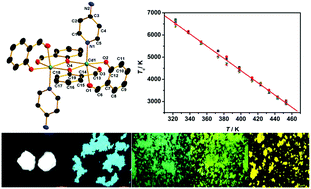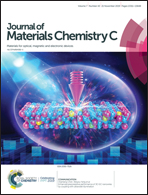Single-component solid state white-light emission and photoluminescence color tuning of a Cd(ii) complex and its application as a luminescence thermometer†
Abstract
A single-component solid white-light emitter, the Cd(II) complex Cd2(Sal)4(PyNH2)2 (1) (where Sal = 2-formylphenolato, PyNH2 = 4-aminopyridine), was synthesized in a simple procedure. Crystals of 1 display almost pure white-light emission upon excitation in a wide range from 300 to 400 nm. The white-light emission of 1 is composed of complementary blue and yellow components in an appropriate ratio, which belong to the ligand to metal (PyNH2 to Cd(II)) charge transfer (LMCT) and the π–π* transition of Sal, respectively. Grinding crystals of 1 led to the transformation into the amorphous state along with the white-cyan-green emission color change and a color change from orange to yellow. The color of amorphous 1 could return to orange when heated. The emission color of amorphous 1 undergoes a gradual change from green to yellow when heated to 180 °C without a change in the molecular structure, and the corresponding color temperature exhibits a linear relationship with the heating temperature in a wide range (323–453 K), which makes amorphous 1 a reliable luminescence thermometer based on the photoemission energy.



 Please wait while we load your content...
Please wait while we load your content...